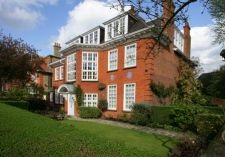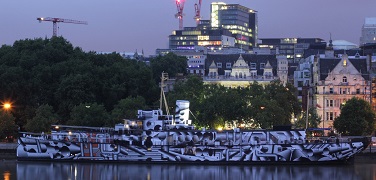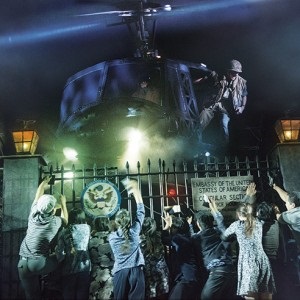
It is almost two decades since I visited Sigmund Freud's Museum in Vienna (which is a tall, thin building with lots of stairs and small, dark rooms) so I figured it was about time I saw how it compared to the Freud Museum in North London where he lived during the last year of his life. It’s a 10 minute and well-signposted walk from Finchley Road tube station although there’s quite a steep climb up Trinity Walk.
The Museum is situated in one of the large houses on leafy Maresfield Gardens. You walk through the front garden, into the vast hallway and sparsely furnished dining room to a small shop at the rear (which used to be the conservatory and overlooks a delightful garden) where you purchase your ticket (£7 adults and children are free) and audio guide as well as books, key rings, mugs and other mementoes.
I went almost straight to the study which had booked-lined walls that displayed many curios, small figures and mask sculptures. Unfortunately, the barriers prevent you from inspecting the books and items at close quarters. The mustiness was quite evocative. It is here that the famous rug-covered couch where the origins of the theory of psychoanalysis began is displayed. As a psychologist and counsellor, I felt a powerful connection to this room which was once inhabited by a man that had such an impact on modern thinking about our mental life.
The unusual chair at Freud’s desk here looks almost like a person – no doubt very symbolic. What struck me also was that this room opened into the front room which is almost an extension of the study – with even more books and figurines. Interestingly, all the chairs were for sole occupancy – maybe the lack of sofas is significant?
The stair case has a startling barbed wire motif leading to the “Why war?” exhibition which was in the exhibition room and commemorates the centenary and looks at the propaganda, the 'pleasure of war' and the psychological aspects of conflict. It was disconcerting to hear music which alternated between popular German songs of the day and British war anthems. There are some touching examples of contemporary art and poetry about war too. But what I found most interesting was the dialogue between Freud and Einstein on the question ‘Is there any way of delivering mankind from the menace of war?’ It seems pertinent in these troubled times.
The Anna Freud room what you would expect a leading child psychologist’s room to look like - a large desk table with the usual items of spectacles, pens, books and telephone and another rug covered couch.
Upstairs in the video room (which also contains large pieces of bedroom furniture) there were plenty of seats available where you could watch two fairly long videos – one showing real clips of Freud and his family and friends in their journey from Austria, through Paris to London (I particularly enjoyed the footage of their much-loved dogs) and another with Freud himself talking about his theories.
I suppose what struck me most about the house was the comparably large hall way downstairs and the large mezzanine/Minstrel gallery landing areas upstairs – which were bright from all the large windows and bestowed with desks and tables in book filled areas – overpowering the relatively smaller rooms of the house.
http://www.freud.org.uk/


